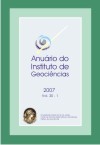Sedimentology and geomicrobiology of the algal matts from lagoa Pitanguinha, Rio de Janeiro State, Brazil
DOI:
https://doi.org/10.11137/2007_1_67-72Abstract
The lagoa Pitanguinha has an area of approximately 0.55 km², of which 1.5 km are in length, it is located between the latitudes of 22º 55'42''and 22º 56'00'' S and longitudes of 42º20'45'' and 42º20'30'' W, at the restinga de Massambaba, near the district of Araruama. The microbial mats are laminate organosedimentary structures and have been called "algal mat", "cyanobacteria mat" and "potential stromatolite", because there is the predominance of cyanobacteria species that are responsible for the formation of the laminate sediment structure. These mats are the oldest known ecosystem. The aim of this study is to determine the geomicrobiology and sedimentary composition of film microbial mats at lagoa Pitanguinha. The film mat appeared to be placed at the intertidal region and has the form of a flat laminae, with a porous and coherent aspect, being composed of lithified sediment compound with crystalclear incrustation. In its inner side the presence shell fragment of bivalve, microgastropod, ostracod and quartz grains of sand size. The main species of cyanobacteria present in the film microbial mat is Entophysalis granulosa Kützing 1843. On the superficial layers of the film microbial mats, sediment grains are much more united due to the presence of filament cyanobacteria that traps and unites the sediment. The rest of the space is filled by spherical cyanobacteria. On deeper layers of the film microbial mats, sediment grains are much more scattered, due to the presence of few filament cyanobacteria and many spherical ones.Downloads
Download data is not yet available.
Downloads
Published
2007-01-01
How to Cite
Silva e Silva, L. H. da, Damazio-Iespa, C. M. and Iespa, A. A. C. (2007) “Sedimentology and geomicrobiology of the algal matts from lagoa Pitanguinha, Rio de Janeiro State, Brazil”, Anuário do Instituto de Geociências. Rio de Janeiro, BR, 30(1), pp. 67–72. doi: 10.11137/2007_1_67-72.
Issue
Section
Article
License
This journal is licensed under a Creative Commons — Attribution 4.0 International — CC BY 4.0, which permits use, distribution and reproduction in any medium, provided the original work is properly cited.















